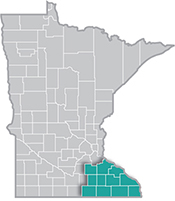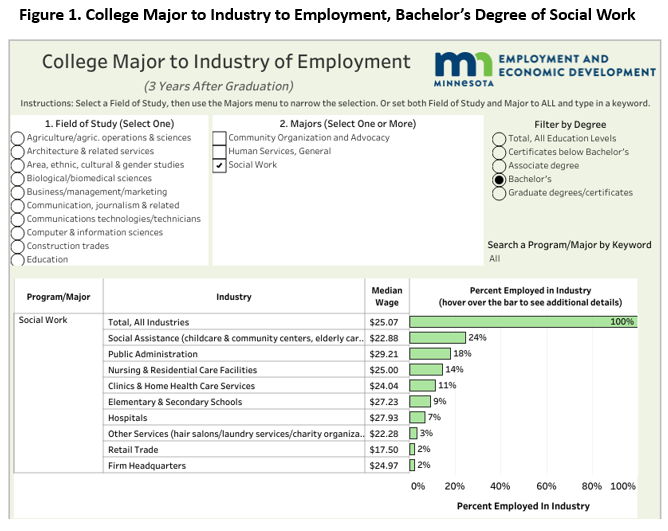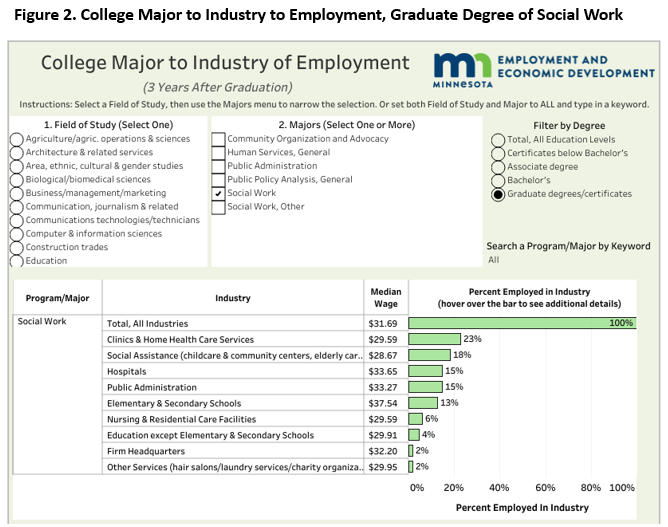 Southeast Minnesota is a health care and agricultural powerhouse. The region is home to the renowned Mayo Clinic and some of the world's most recognized food companies and brands.
Southeast Minnesota is a health care and agricultural powerhouse. The region is home to the renowned Mayo Clinic and some of the world's most recognized food companies and brands.
Advanced manufacturing is especially strong here, with machinery, chemicals, and electronics among the top products.
Want the freshest data delivered by email? Subscribe to our regional newsletters.
3/26/2024 9:00:00 AM
Amanda O'Connell
The National Association of Social Workers celebrates March as Social Worker Month, highlighting the significant and varied roles of Social Workers across different sectors. These professionals are engaged in a wide array of areas, including health care, the criminal justice system, child welfare, education, substance abuse recovery, disability services, mental health care and research, just to name a few. In this month's blog, we will explore employment data of Social Workers in Southeast Minnesota and examine the career trajectories for individuals who earn a degree in Social Work in the state.
| Table 1. Occupational Employment & Wage Statistics, Q1 2023 | ||||
|---|---|---|---|---|
| Occupations | Southeast Minnesota | Minnesota | ||
| Estimated Employment | Median Hourly Wage | Estimated Employment | Median Hourly Wage | |
| Community & Social Service Occupations | 4,480 | $28.75 | 54,820 | $25.82 |
| Child, Family, & School Social Workers | 490 | $29.38 | 7,400 | $31.74 |
| Healthcare Social Workers | 350 | $28.07 | 2,690 | $31.23 |
| Mental Health & Substance Abuse Social Workers | 240 | $32.74 | 2,690 | $32.31 |
| Social Workers, All Other | 570 | $38.00 | 3,620 | $32.85 |
| Source: DEED Occupational Employment & Wage Statistics | ||||
An estimated 1,650 Social Workers were employed in Southeast Minnesota, with median hourly wages ranging between $28 and $38 per hour in the first quarter of 2023. Healthcare Social Workers earned the lowest median wages, while Social Workers, All Other have the highest earnings. Both Mental Health & Substance Abuse Social Workers and Social Workers, All Other reported higher wages than the state as a whole. Child, Family, & School Social Workers were the largest, with 490 people employed at organizations in the region.
Usually, those who want to become Social Workers must earn a Bachelor's in Social Work from a recognized college or university. The field of Social Work they choose might also require extra or specific training. In Southeast Minnesota, students can start their journey at one of four community colleges 1 that provide a Pre-Social Work Transfer Pathway. This pathway allows students to earn an associate degree with classes and credits that can be transferred to a bachelor's degree program at any Minnesota State University. For those in Southeast Minnesota seeking to obtain a Bachelor's or Master's in Social Work, Winona State University is the only institution in the region offering these programs.
The data tool highlighted in "Popular or Pragmatic Part 2: The Long View" provides a detailed examination of earnings by major seven years after the class of 2015 graduated. Graduates with a bachelor's degree in any field had a median annual salary of $66,312, seven years post-graduation. In contrast, those who majored in Social Work in 2015 had a slightly lower median salary of approximately $58,000 seven years on, which aligns with the cost of living for a single person in Minnesota but falls around $2,500 short of the typical family's2 cost of living in the state. The data also reveals a salary growth of 33.3% from $43,722 two years after graduation to $58,288 seven years after graduation, suggesting that increased experience and further education can lead to higher wages over time.
In addition to bachelor's degrees, the data tool also evaluates salary outcomes for individuals with graduate degrees in Social Work. Seven years post-graduation, the median annual income for those holding a graduate degree in any field was about $88,000. Meanwhile, those who completed a graduate program in Social Work in 2015 saw a median yearly income of approximately $73,000 seven years afterward, which is below the overall median for all graduate degrees. However, this income level exceeds the cost of living for a single Minnesotan and a typical family in Minnesota.

The newly released "College Major to Industry of Employment" tool provides additional insights into the outcomes of graduates. Figure 1 displays the tool's data for those who earned a Bachelor's in Social Work from 2016 to 2019, highlighting the industries that employ these graduates and their median earnings. The largest portion, 24%, of Social Work bachelor's degree holders are employed in the Social Assistance sector, followed by 18% in Public Administration, 14% in Nursing & Residential Care Facilities, 11% in Clinics & Home Care Services, 9% in Elementary & Secondary Schools, 7% in Hospitals, with Other Services, Retail Trade and Firm Headquarters each employing around 2% to 3%. The median hourly wages vary by industry, with Public Administration offering the highest at $29.21 per hour and Retail Trade the lowest at $17.50 per hour.
For those with graduate degrees in Social Work, similar data is presented in Figure 2. Figure 2 reveals that nearly a quarter are employed in Clinics & Home Health Care Services, with 18% in Social Assistance, 15% in Hospitals, another 15% in Public Administration, 13% in Elementary & Secondary Schools, 6% in Nursing & Residential Care Facilities, 4% in Education (excluding Elementary & Secondary Schools) and 2% each in Firm Headquarters and Other Services. The highest median hourly earnings are in Elementary & Secondary Schools, at $37.54, while the lowest are in the Social Assistance sector, at $28.67.

Social Worker Month, celebrated by the National Association of Social Workers, is a timely reminder of the invaluable contributions Social Workers make across various sectors. From health care and education to public administration and beyond, Social Workers in Southeast Minnesota and throughout the state are pivotal in addressing and supporting the well-being of individuals and communities. The data presented highlights not only the diversity of employment opportunities available to those with degrees in Social Work, but also underscores the financial viability of this profession in meeting the cost of living in Minnesota.
Contact Amanda O'Connell, Labor Market Analyst, at amanda.oconnell@state.mn.us.
1MN State College Southeast – Reg Wing, MN State Southeast – Winona, Riverland Community College – Austin, and Rochester Community & Technical College
2A typical family is defined by DEED as 1 full-time worker and 1 part-time worker with 1 child. The cost of living for a typical family in Minnesota is $60,720.